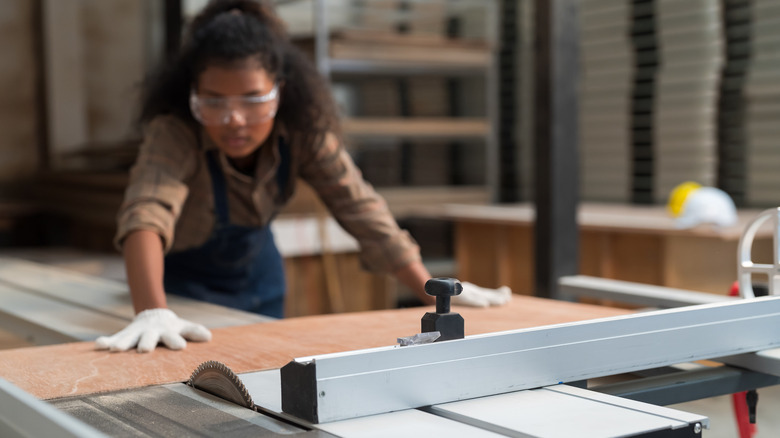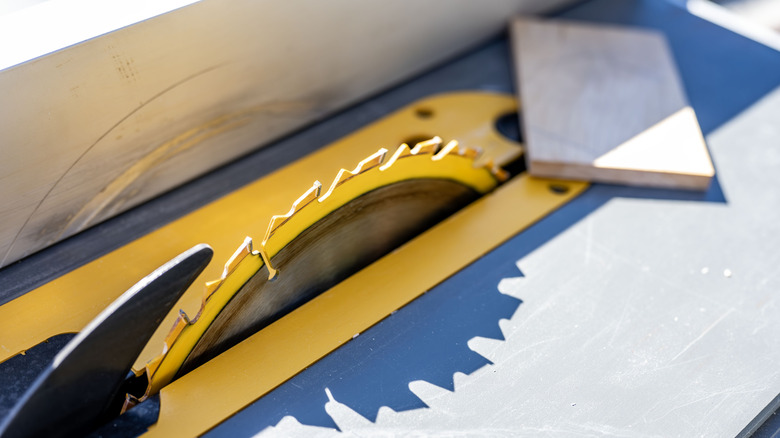What To Look For In A Used Table Saw
Whether you're a longtime professional or a newcomer to woodwork, owning a table saw is the ultimate goal for any hobbyist. Of all the saw types out there, none match the power, efficiency, and accuracy of table saw in the right hands. The biggest barrier to getting one, other than space needed, is the immense price tag attached to many top tier table saw models, with many commonly costing $400 to $500 on the lower end.
While some may give up at that point and go with an alternative tool, those dead set on getting their hands on a genuine table saw may choose to find their desired saw secondhand. This can certainly help in saving money while also allowing you to get a better idea of what the specifics of your tool entails rather than shopping blind at a big box store. Additionally, you're helping reduce the waste that would otherwise come from new parts being manufactured or the old saw rotting in a landfill.
At the same time, it's natural to feel apprehensive about making such a move. We all know the pain of getting something on a bargain that ends up breaking down sooner than expected, or ultimately losing you more money and time in the long run. However, this doesn't have to be the case with your used table saw. By going in knowing what to look for and taking the time to thoroughly inspect the saw before purchasing, you can save yourself on headache and hassle.
Make sure its in good phyiscal shape
The saying "don't judge a book by its cover" is applicable in many cases, but not so much when buying a used table saw. While the true test of a table saw's merit should be its performance, its appearance and physicality is a generally good indicator of its overall condition. As a result, you should take the time to closely inspect various aspects of the table saw you have your eyes on before purchasing.
When viewing your table saw, pay special attention to physical aspects such as the blade, table top, fence, pulleys, and arbor. While some scratches may not be all that concerning, red flags should be raised if any significant signs of wear and tear are spotted. Steer clear if you see rust, cracks, rough edges, or missing segments, as these are key indicators that the table saw doesn't have much life to it, giving you an inefficient performance at best. It's also crucial to ensure that certain sections such as the fence and blade are properly aligned, as having these components be out of place can increase the likeliness of kickback and similar hazards.
There is a flip side to this equation, however. While you should certainly never use a table saw with missing or broken parts, you may still be able to get replacements parts by shopping online or contacting the manufacturer. This also gives you more leeway to negotiate a lower price for the table saw. Weigh out if it makes more economic sense to go down this route or to simply buy a new table saw.
Check to make sure it can perform
Whether new or used, the biggest concern in regards to your table saw is how well it works. If going for the latter option, it's especially important that you know your intent with the tool. How often will you be using it? What kinds of materials are you planning on cutting with it? How heavy duty are the jobs you intend to perform? Likewise, it helps to ask the seller beforehand about the saw's history and usage.
Always ask the seller if you can test out the table saw before purchasing (refusing to do so that should be a warning sign that there's something they don't want you to see). Plug in the table saw and hear how it sounds starting up, ensuring there's no incessant vibration or other strange noises. See if you can try putting a load through the saw, preferably of an amount that you intend to put through regularly. Do this with a new blade so you can test how easy it is to install one, as this will be an important task you'll need to perform regularly. If it's struggling to take on a load by making loud noises, shaking, or even releasing fumes or smoke, it could be a sign that the motor is worn out. Once again, however, this is a situation where you may be able to find replacement pieces that can get things up and running.


